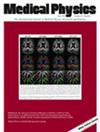Design, manufacturing, and multi-modal imaging of stereolithography 3D printed flexible intracranial aneurysm phantoms
Abstract
Background
Physical vascular phantoms are instrumental in studying intracranial aneurysms and testing relevant imaging tools and training systems to provide improved clinical care. Current vascular phantom production methods have major limitations in capturing the biophysical and morphological characteristics of intracranial aneurysms with good fidelity and multi-modal imaging capacity. With stereolithography (SLA) 3D printing technology becoming more accessible, newer flexible and transparent printing materials with higher precision controls open the door for improving the efficiency and quality of producing anthropomorphic vascular phantoms but have rarely been explored for the application.
Purpose
This technical note intends to report the feasibility of using SLA 3D printing technology to manufacture flexible intracranial aneurysm phantoms with similar scales to the real anatomy, as well as their capacity for multi-modal flow imaging and analysis, including ultrasound flow imaging, high-speed filming, and particle image velocimetry analysis.
Methods
We designed and 3D-printed two intracranial aneurysm phantoms with an SLA 3D printer using Formlabs Elastic 50A resin. By using a micropump to introduce cyclical flows in the phantoms, we first employed conventional Doppler and vector flow ultrasonography to observe and measure different fluidic properties. Then, a high-speed camera was used to record particles flowing within the phantom, and we further conducted a particle image velocimetry analysis, including the distribution of mean 2D velocity vectors, average velocity magnitudes, and the mean vorticity fields in the phantom for the high-speed imaging data.
Results
We successfully 3D-printed flexible intracranial aneurysm phantoms with similar dimensions to the real anatomy. Additionally, we validated the phantoms’ ability to allow visualization, measurement, and analysis of flow dynamics based on both real-time ultrasound and optical imaging.
Conclusions
Our proof-of-concept study illustrates that SLA 3D printing using commercial elastic resins can significantly contribute towards facilitating the fabrication of flexible intracranial aneurysms phantoms for training, research, and preoperative planning.


 求助内容:
求助内容: 应助结果提醒方式:
应助结果提醒方式:


